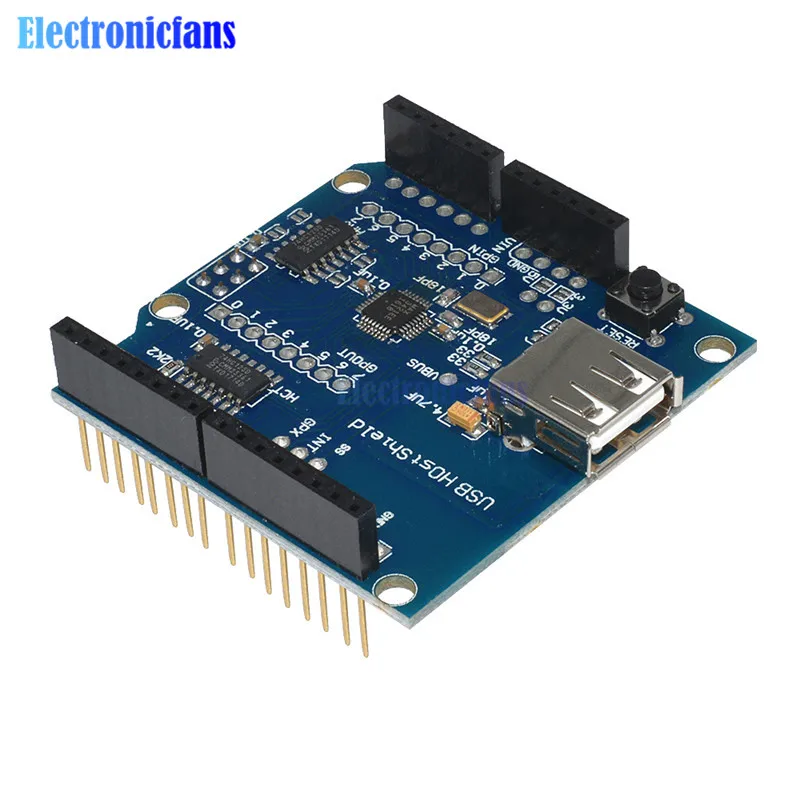

- #Diy arduino usb host shield for free#
- #Diy arduino usb host shield software#
- #Diy arduino usb host shield Pc#
#Diy arduino usb host shield software#
Others like the papilio (based on Xilinix FPGA) don't claim software capatibility, just compatibility with the UNO header pinout. Some feature the pic processor rather than the arduino's Atmel. Many companies are making "almost compatible" arduino products like the Pinguino. The uno header pin out and compatibility with arduino software are the two major features of all arduino boards. The arduino has spun off a number of competing open source hardware projects. There is a protoboard shield that adds no features other than providing a platform on which to build unique circuits. The shields themselves may have additional features. The Uno pins move up through the headers and thus are available to all the shields. This for example would enable one UNO to talk to another. Pins 0 and 1 stand for transmit and receive. This enables an Uno to change the speed of helicopter propellers. This enables the control of Electronic Speed Controllers (ESC). Pins 3,5,6,9,10,11 are PWM or Pulse Width Modulation pins, meaning that the time on and time off do not have to equal. Or they could tell a fax machine LCD panel what to say.

The digital pins put out either 0 or 5 volts. Doing this enables the Uno to be more accurate when converting information from the 6 analog pins to numbers. Anything different will have to be connected to the AREF pin. 1.1 and 3.3 volts can be selected through software. A different maximum voltage for the Analog pins can be connected here and then selected through software. The maximum voltage defaults to 5 volts, but can be changed to 1.1 or 3.3 volts through software. The Uno can turn the voltage into a number between through the Analog pins. EEG, ECG, temperature sensors, light sensors, and strain gauges are examples of devices that turn physical measured information into a voltage. Six pins (or holes where pins go) are clearly labeled on the Uno. That is why a USB Host shield for the Arduino exists. The USB port on an Uno is a slave port, not the USB On-The-Go port found in cell phones. USBĪ USB mouse or keyboard can not be plugged into the Arduino as if it were a computer. Once the program is downloaded, the USB cable can be disconnected (if another power source is available) and the program will run without a computer. The USB cable is designed to be attached to a computer so that software can be downloaded to the Arduino. This is especially true if motors are involved. At this point the individual shields may need their own power sources. Things will then work, more will be added and eventually the Uno will stop working again. The solution is to plug in a 5 to 12 volt DC in cable to the Uno. Eventually adding stuff to the Uno will cause everything to stop working. The Uno can be powered through the USB cable.
#Diy arduino usb host shield for free#
They are popular because they give away the software development environment (C language) for free and they scale up to supporting Linux. Two popular microcontroller companies used in the DIY community are AMTEL and Microchip PIC. Microcontrollers exist in a variety of configurations and price points starting at under two dollars for quantity one. They are found in embedded applications such as the control panel of a microwave, printer or car dashboard. Microcontrollers differ from modern CPUs in that IO, RAM, and Flash memory are imbedded in a single chip.
#Diy arduino usb host shield Pc#
Microcontrollers evolved from the same microprocessors that started the PC revolution such as the Motorola 6502 and Intel 8088. The discontinued Arduino Duemilanove, replaced by the UNO in late 2010


 0 kommentar(er)
0 kommentar(er)
